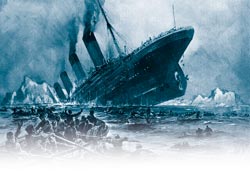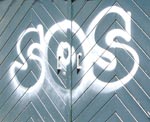Sending out an SOS
How a famous disaster spurred agreement on international rules
|

Willy St÷wer |
|
|
Titanic sank in 1912 with the loss of nearly 1600 lives |
|
As reported in the April issue of ITU News, this
year marks the centenary of the International Radiotelegraph Conference held in
Berlin in 1906, where 29 countries signed a convention on wireless communication
for ships at sea. Its annex laid down the first international rules for wireless
telegraphy — today known as the Radio Regulations — which became a cornerstone of ITU’s work. Very soon after its invention, this technology had been
adopted as a way for ships in distress to summon help. It was necessary to set a
standard for communication that everyone, from whatever nationality, would be
able to understand, especially in an emergency.
|
|

ITU 770405/Marconi Corporation |
|
|
Guglielmo Marconi is seated at a radio transmitter on board a ship. He had
booked a passage on Titanic’s return journey to Europe, which was never to be
made |
Morse code
As in the telegraphy that was sent across land, Morse code was the method
used by ships’ wireless operators for conveying information. But what distress
signal would be universally understood? Before the 1906 agreement, various
countries and organizations each decided their own signals for shipping. One of
the most widely adopted was the “CQD” of the Marconi International Marine
Communication Company. The first two letters (CQ) were already used in landline
telegraphy for announcing a general call to all stations, and the “D” was added
to stand for “distress.” This gives part of the answer to the question posed on
last month’s Pioneers’ Page: who signalled “CQD…MGY, ….CQD…MGY” and when?
It was sent on 15 April 1912 by a ship in distress, which the second group of
letters (MGY) specifically identified as “Titanic.”
The tragic maiden voyage of the British liner Titanic is a well-known story.
On the night of 14-15 April, the ship struck an iceberg off the coast of Canada
and sank with the loss of nearly 1600 lives. Could more people have been saved
if radio communications had been better managed? Almost certainly, the answer
is: yes.
A night of confusion
Six years after the agreement at the Radiotelegraph Conference, not everyone
had adopted its rules. More than one emergency signal was still in use. The
sinking of the Titanic also highlighted the lack of 24-hour radio communication
on ships, and that even when messages were heard, in some cases operators were
unwilling to respond.
It was a common practice only to communicate by radio during daylight hours.
“Californian,” the closest ship to the sinking Titanic, did not hear her
distress call because radio operators were not on duty overnight. The rockets
fired by Titanic also confused the Californian’s crew, perhaps because ships
owned by different companies had many differing patterns of lights for
communicating at night. Commercial rivalry also played a part. Wireless
operators were the employees of the companies that supplied ships’ radio
equipment, and these firms fought hard to capture market share. This meant that
operators working for one firm might not respond to radio signals coming from an
operator working for a rival. It seems this is what happened to some of the
signals passed between Titanic (using a Marconi system) and other ships.
Another difficulty could have been that Marconi operators were still being
instructed to use “CQD” to signal distress, and this was transmitted for much of
the time by Titanic’s wireless operator John Phillips (who was to die in the
sea). Eventually, as suggested by assistant operator Harold Bride, he
interspersed this with the new signal, “SOS.”
Shocked into action
The “SOS” signal originated in national radio regulations issued in Germany
in 1905, and was adopted internationally by the Berlin conference in 1906. The
conference decided that “ships in distress shall use the following signal: . . .
_ _ _ . . . repeated at brief intervals.” It is a continuous group of Morse dots
and dashes, rather than separate letters, and was chosen because the pattern is
simple and unmistakable. However, because it can be read as “SOS” in Morse code,
this became the usual mnemonic for the signal.
The sinking of the Titanic spurred maritime authorities to improve emergency
procedures. Just a few months after the tragedy, the 1912 International
Radiotelegraph Conference, held in London, agreed on a wavelength of 600 metres
(about 500 kilohertz) for ships’ radio distress signals. Also, every ship was
instructed to maintain a three-minute radio silence at 15 and 45 minutes past
each hour, when operators should listen for distress calls. In 1914, the
International Convention for the Safety of Life at Sea (SOLAS) was signed,
requiring (among other safety measures) all ships carrying more than 50
passengers to have a radio on board.
|

Janet Burgess |
|
The final SOS
Because it is such a memorable code, “SOS” has been adopted into general use
whenever people want to impart the idea of emergency. Flood victims, for
example, have written it on the rooves of their homes to signal rescue
helicopters, and the well-known letters can even be seen quite frequently on
banners in protest marches for various causes. The use of “SOS” as an official
distress signal, though, ended on 1 January 1998, replaced by modern satellite
communication systems and the use of voice messages, rather than Morse code. But
on the very night before the regulations were to change, a ship in distress used
the old signal.
The MV Oak was carrying timber from Canada to the British port of Liverpool
when it lost engine power and its cargo shifted dangerously in a storm. On 31
December 1997, it reportedly signalled “SOS…SOS. This is Oak. Position 53 16 N,
24 59 W. Stop engine. We need assistance.” The British Coast Guard responded
immediately, even though they at first thought the message might have been a
joke: it was New Year’s Eve and not having heard a Morse code “SOS” for many
years, they had suddenly received one on the last day of its official use.
Fortunately, the crew of MV Oak proved to be safe in lifeboats, having sent the
final “SOS” in the 90 years of the signal’s history.
Question for next month
One hundred and fifty years ago this July, a scientist was born in the
Balkans at the stroke of midnight during a thunderstorm. He ended his career
working on a “death ray.” Who was he?
The answer will appear in the next issue
of ITU News.
|
|


